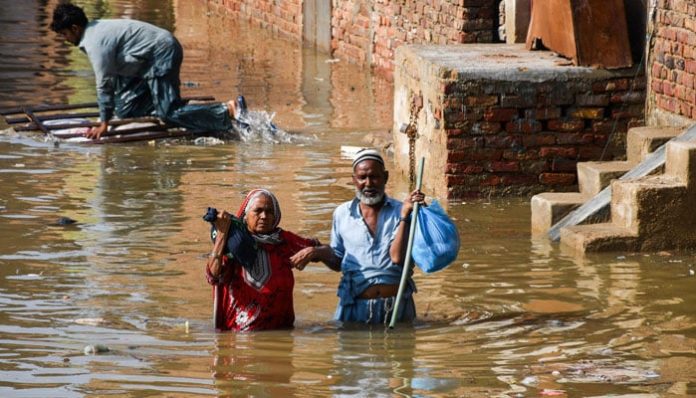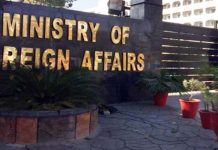Staff Report
ISLAMABAD: Pakistan’s death toll from this year’s monsoon rains has climbed to 802, with over 1,088 people injured and nearly 7,465 houses damaged, figures released by the National Disaster Management Authority (NDMA) showed on Tuesday.
Khyber Pakhtunkhwa (KP) has reported the highest number of fatalities at 479, followed by Punjab with 165, Gilgit-Baltistan with 45, Sindh with 57, Balochistan with 24, Azad Jammu and Kashmir (AJK) with 24, and Islamabad with eight deaths. The gender-wise breakdown showed 480 men, 119 women, and 203 children among the deceased.
Punjab reported 584 injured, KP 347, Sindh 75, GB 45, AJK 29, Balochistan five, and Islamabad three. At least 4,243 houses were damaged in KP, 1,642 in AJK, 1,029 in GB, 220 in Punjab, 175 in Balochistan, 91 in Sindh, and 65 in Islamabad.
Flood emergency and rescue operations
Prime Minister Shehbaz Sharif, chairing a high-level meeting on the flood situation, was informed that over 174,000 people had been evacuated from inundated districts of Punjab following the flooding of River Sutlej.
He directed authorities to accelerate rescue operations, particularly in flood-hit districts along the river, and to ensure timely provision of food, medicines, and tents.
The NDMA chairman was ordered to maintain close coordination with the Punjab Provincial Disaster Management Authority (PDMA).
Authorities reported that advance warnings had enabled evacuations, preventing casualties in some areas despite high-level flooding in River Sutlej at Ganda Singh Wala and Sulemanki, River Ravi at Jassar, and River Chenab at Marala. Severe flooding was also reported in Nullah Dek.
In Narowal, evacuation from the Lehri Bund area was underway, while power restoration efforts were ongoing in parts of KP.
In Gilgit-Baltistan, repair work was in progress on a two-kilometre stretch of the submerged National Highway. Forecasts warned of heavy rains in the next 12 to 24 hours in Lahore, Gujranwala, Gujrat, Rawalpindi, AJK, and several districts of Gilgit-Baltistan.
River overflows, cross-border water release
The flooding intensified after India released additional water into Pakistan’s rivers. As a result, floodwaters surged in the Ravi, Chenab, and Sutlej, causing breaches in Narowal, Sialkot, and Shakargarh.
In Zafarwal, part of Hanjli Bridge collapsed under the pressure of Nullah Dek, cutting off road links to dozens of villages.
At Head Marala on the Chenab, water inflow rose to 350,000 cusecs, while Sutlej’s flow at Ganda Singh Wala swelled to 188,000 cusecs, reaching extremely high flood levels.
In Bahawalpur’s Khairpur Tamewali and adjoining river belt areas, floodwaters rapidly spread, damaging crops across thousands of acres, houses, and government schools.
Sialkot received 335 millimetres of rain within 24 hours, inundating homes and paralysing life, as well as breaking an 11-year-old record.
India’s release of an additional 200,000 cusecs into the Ravi and the expected 100,000 cusecs into the Chenab has raised fears of very high flooding in the next 48 hours.
Rescue teams continued shifting stranded residents by boats from river-adjacent areas, while Shakargarh’s Nullah Bainsi and Nullah Basantar overflowed, submerging connecting roads and several villages.
In Shakargarh, a roof collapse killed one woman and injured two children.
Tragedies
In Buner district, the only cremation ground of the Sikh community was washed away, along with businesses and shops, prompting calls for government assistance.
In Chagharzai tehsil, 18 members of the same family were buried in a mass funeral after being swept away in floodwaters.
The body of one child remained missing as the grief-stricken atmosphere prevailed.
In Shangla’s Khwar Banda area, nine members of another family perished in floods.
A man named Rafiullah lost two sons and a daughter in the disaster, while his wife was said to be in deep mental distress.
Government response
Prime Minister Shehbaz Sharif reiterated that Pakistan is among the countries most affected by climate change. He recalled that the 2022 floods had inflicted losses worth $30 billion, displacing millions and destroying entire villages.
“We cannot tackle this challenge alone,” he said during an event, urging for coordinated global action.
The NDMA chairman, earlier in the day, briefed the Public Accounts Committee that Pakistan hosts around 7,500 glaciers, warning that a two-degree rise in temperature could cause 65 percent of them to melt over the next five decades.
Lawmakers criticised the NDMA’s lack of preparedness, with committee member Junaid Akbar remarking that the authority seemed only equipped to retrieve bodies and repair roads.
Another member, Sanaullah Masti Khel, alleged that funds meant for early warning systems had been diverted to the Benazir Income Support Programme, and said he would file an FIR if given the authority.
The NDMA chief also warned that the eighth spell of monsoon rains is expected to begin tomorrow.




